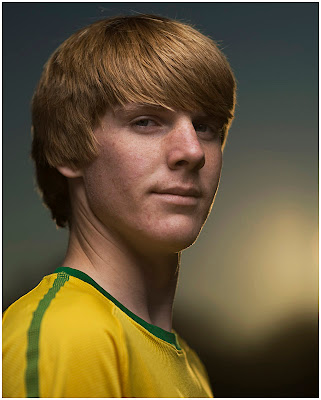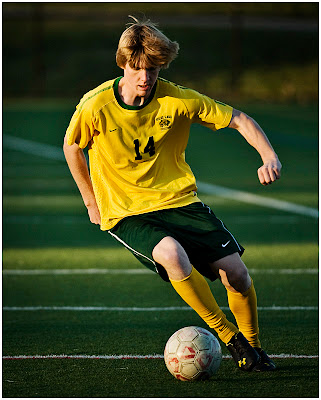On Assignment: Soccer Through Sunset

Any time I am shooting an outside portrait and the start time is up to me, I am for an hour before sunset. The reason is simple: You know the light is gonna just get better and better until it is time to wrap it up.
That's exactly how it was with a shoot last week of local soccer standout Zach Johnson. But this time we veered away from the normal afternoon/sunset game plan a little.
__________
Normally, I like to start with late afternoon sun as my key, because the light just keeps getting sweeter as it morphs into that final ten minutes of magical golden hues. And afterward, the post sunset light stays soft and directional until the sky becomes a perfect backdrop for off-camera flash.
Shooting both a head shot and action photos, we switched things up a little this time. We shot into the afternoon sun, then used golden light for action shots before setting up a few strobes to mimic nighttime stadium lighting at the end.
Shooting directly into late afternoon sun can wreak havoc on your exposure. The range of tones is pretty extreme. Turn your camera just a smidge into or away from the sun and your ambient exposure can move several stops.
So I like to use a wide aperture and work with the sun right outside of my frame. This creates a beautiful palette of soft light, with your subject sillo'd in the front. And the sun becomes a gorgeous rim light. The shot above was at f/2.5, so you could do it with just about any portrait-length lens.
Step By Step
To flash into that sun at a wide aperture, you'll need to use either high-speed sync or a neutral density filter. I'm not a big fan of high-speed sync because (a) it robs your power, and (b) you have to pay for the capability on every new light you buy.
With ND, you pay up for a hi-quality filter once and you can use it for every flash, every lens, every platform. Don't skimp on glass here. And while flashing into backlight with an ND filter is pretty straightforward, there are a few steps involved.
First, drop your camera to a low ISO. Light quantity is not gonna be your problem here, so you may as well get the image quality while you control your ambient level. I like to go to the native ISO of my camera, which is 100. Next, go to your max hard sync speed to bleed even more of that ambient out.
Now, close down your aperture to create the desired exposure for your background and watch all of that creaminess disappear. In it's place, you get to see every single spec of sensor dust. Enjoy.
This background exposure level is what you will balance your subject to, with flash. Bring your light in nice and close. You are shooting tight to keep that creamy out-of-focus background in the final image.
Position your light and adjust your power level until your subject balances with the background. Now, you are ready for your ND filter. There are several ways to ND a lens, but I love the Singh-Ray Vari-ND for its great optical quality and stepless range of densities.
As you dial in neutral density in front of the lens, you can take out the stops via the aperture to make up the difference. Go all the way to wide open if you like.
The important thing to remember, is you are still keeping that same 1/250th ~ f/16-ish relationship between strobe and sun. But you are bleeding away the aperture (and depth of field) with the ND filter.
That's why you need power, which is exactly what proprietary high-speed sync systems rob you of. Cough up for one good ND filter and you can do this setup with any flash.
What you are left with is a sharp, lit subject and a very atypical (for flash) out-of-focus backdrop. It evokes a larger film format to me, mostly because larger camera give a look with less depth of field.
For this headshot, my key light was a Profoto B600, in an FTX white beauty dish. The dish was in very close -- maybe two feet away -- which helped me two ways.
One, the light got really soft because of the apparent size of the light source. Two, the close range made things very efficient. My white dish is not the most efficient mod in the world. But at this range I was able to balance what had been f/16 (before the ND) with about 100 watt-seconds of power.
So there is only one flash being used. Shadows were filled from a Tri-Grip flexible reflector held underneath.
__________

Instead of shooting more headshots with the golden light as key, we decided to use that for some running shots. I had Zach move down the field, and told him to treat each streak of golden light coming through the trees as a defender. That way I knew he'd be making lateral moves every time he broke into an area of nice light.
Normally when I shoot sports, this happens exactly the opposite way. Nice to be in control for a change.
We used the last bit of golden light on action shots, then used the post-sunset afterglow period to set up a trio of flashes for a motion shot with a little more cowbell.

For the post-sunset shot, I wanted to do something that mimicked stadium light. The field was surrounded by trees, so the horizon wasn't the greatest. But we decided to go for it anyway.
We used the stadium light to motivate the key, meaning that we wanted the key to appear to be coming from the stadium lights. Or at least close enough for your brain to fill in the dots.
So that light was the B600 again, about 40 feet away and on very low power with a hard reflector.
That gave us Zach's face. But we still needed some detail up front. So I stuck a slaved SB-800 on the ground right next to my camera and dialed it way down. I just wanted a little legibility in the shadows on Zach.
Finally, we needed some kind of separation light coming from back camera right. The trees were pretty grody back there and of course he is wearing black shoes. So another slaved SB-800 on a stand was tasked for that. Perfectly logical, too, as you would expect another set of stadium lights off to the right.
No ND filters here. We needed all of the aperture could get, to be able to zone focus as he drove through the shooting area. As the ambient kept getting darker and darker, I kept panning right to left as Zach came through. This minimized the damages of shooing fast action at a 1/250th of a second. (Works at lower shutter speeds, too.)
__________
Zach's a pretty intense guy -- as is his younger brother Chris, who was feeding him the passes. He still had plenty of gas left as the last bit of ambient forced us to shut down.
But by moving through the different phases of ambient, we were able to get a nice sequence of situations in pretty short order.
Next: Lighting Inside the Box
__________
New to Strobist? Start here | Or jump right to Lighting 101
My new book: The Traveling Photograher's Manifesto
Permalink
<< Home